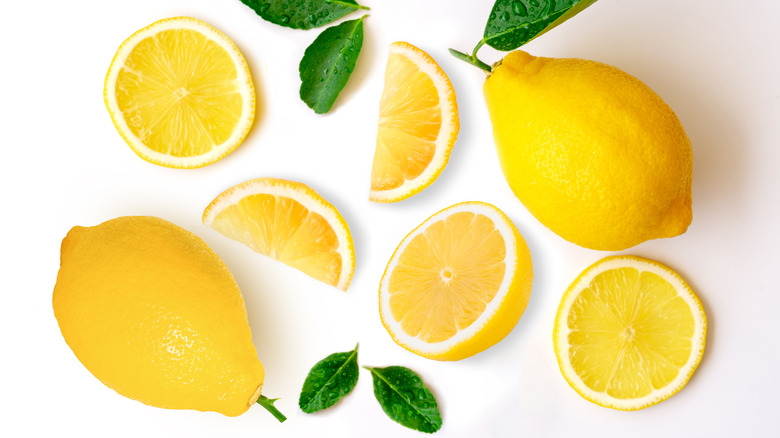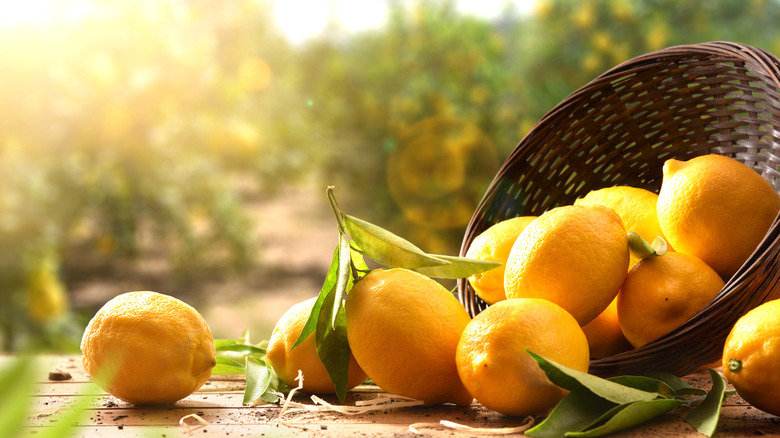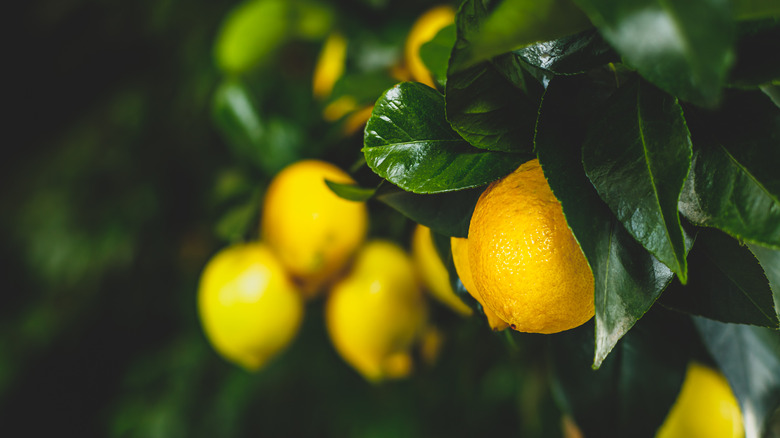Most Of The Lemons In The US Come From This State
They make you pucker, they make you squirm, and even the memory of their flavor makes you salivate. Lemons are nature's little citrus gem. More acidic than the orange, the lemon is known for its wonderful refreshing and zesty flavor, which we mix into cocktails like the martini or the Meyer Lemon Tom Collins (via Health Shots). It is also the essential flavor in classic bakes such as the chess pie, lemon meringue, lemon poppyseed cake, and even Jesmary Sbraga's classic lemon tart.
The point is lemons are meant to be loved, and the near-painful puckering they cause is just part of the fun! For the same reason, some people enjoy the hottest of hot sauces, while others enjoy the sourest of lemons. According to Statista, the United States consumes an average of 26.9 pounds of fresh citrus fruit annually per capita. Americans love a splash of citrus over their tacos and on the rim of their glasses, which is why we rely on domestic and foreign citrus growers to give us our fix. You need not look further than the sunny planes of California to see where most of our home-grown lemons come from.
The Californian lemon
California is notorious for growing much of the United State's produce. Per Net State, the golden state is the main producer of apricots, strawberries, lemons, and many more fruits and veggies, all thanks to the state's permanent sunny disposition. California has some incredibly deep, rich soil and a Mediterranean climate, making it perfect for growing the 400 different crops it boasts (via Farm Together).
Between 2019 and 2020, the United States Department for Agriculture reported that the total boxes of lemons produced in the country reached 27,500,000. California alone yielded 25,700,000 boxes from its 50,000 acres of lemon trees. The state produces so many lemons that See California says that citizens have thrown an annual lemon festival in Chula Vista since the 1920s. The point is that Californians take their citrus seriously, growing six varieties: the Eureka, Pink Variegated, Lisbon, Meyer, Primofiori, and Verna to squeeze into drinks and dishes (via Balcony Garden Web).
What are lemons?
If you didn't grow up on the sunnier side of the West Coast or in the Mediterranean, odds are you haven't seen lemon trees casually growing about like it's no big deal. To most of the world's population, the lemon is some kind of mystical fruit that only thrives in the sun and appears in grocery stores like magic. But lemons, while magical in flavor, are much like any other fruit. The SF Gate says that the reason you probably haven't wondered about a lemon tree in the wild forests of the Rockies or Appalachian mountains is that citrus fruits grown in tropical and subtropical humid regions prefer temperatures consistently between 77 degrees Fahrenheit and 86 degrees Fahrenheit. Due to these growing restrictions, California, Arizona, and Florida are the leading producers of lemons in the U.S., with California leading the charge (via Wisconsin Department of Public Instruction).
Lemons are fantastic for adding a bright zing to your food, but it is also good for other things. Healthline reports that lemon is good for your heart and overall cholesterol and is notorious for its abundance of vitamin C. People enjoy lemons fresh, baked, dried, juiced, and candied throughout the world, thanks to global trade and markets, so don't skimp on your daily dose of lemon!
History of the lemon
Though the lemon thrives in California's climate, it is by no means native to the Americas. Lemon seeds hadn't reached the shores of the Western world until just about 600 years ago when European colonizers made their way onto Native lands. And even before then, the introduction of the lemon tree to Europe was relatively new. According to Britannica, Spain only received the fruit between 1000 and 1200 AD. So, where was this citrus before it made its way westward?
Young Living claims that lemons have been successfully cultivated for over 4,000 years. Though the exact origin of the fruit is unknown, it is believed that the citrus was brought from Asia into the Middle East around 200 BC, where it was then quickly adopted and cherished by those in Turkey, Israel, and Rome. The lemon played an important role in cultivating a love for citrus in the culinary world, says the University of Washington Botanic Gardens. Those who practiced Hinduism and Judaism had an ardent appreciation for the lemon, and the fruit became an important part of Arab and Persian culture. Lemons can be found farmed around the world and harvested in India, China, Argentina, Brazil, Turkey, Spain, and, of course, the United States (via Atlas Big).



